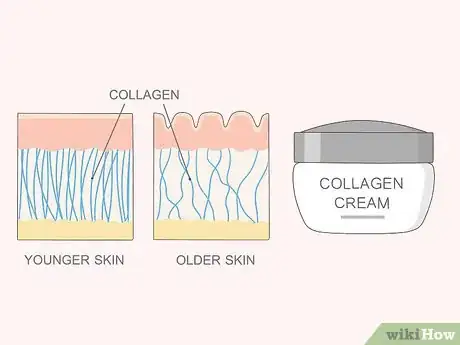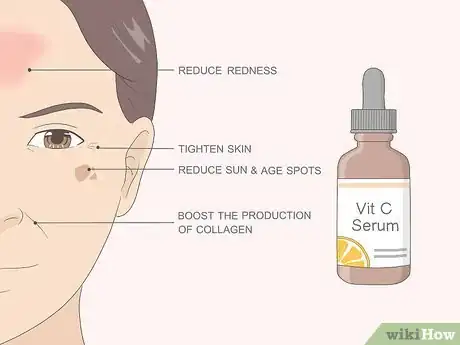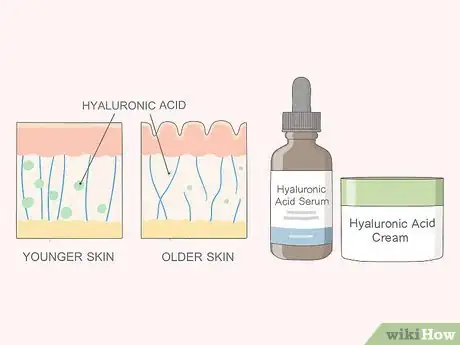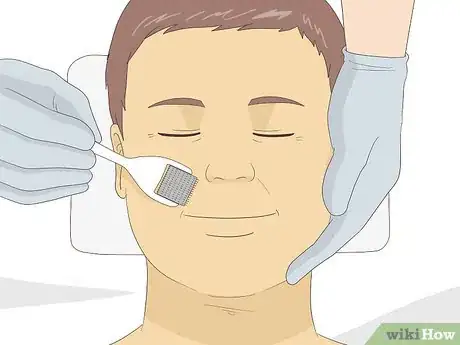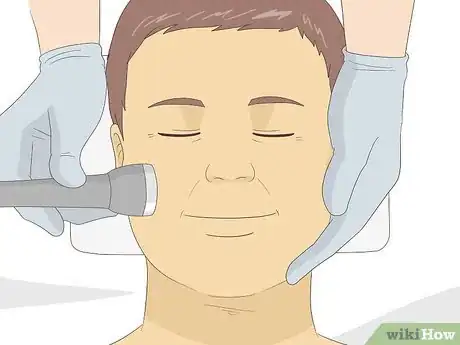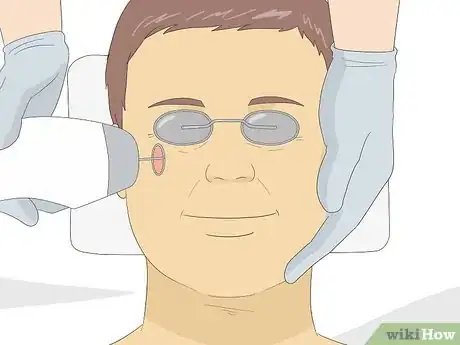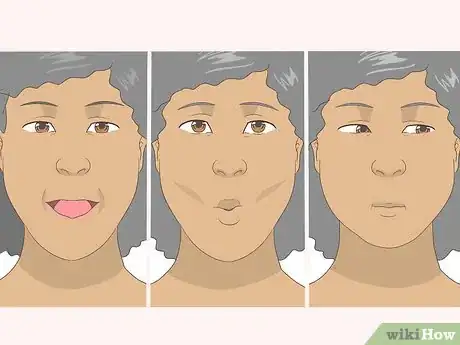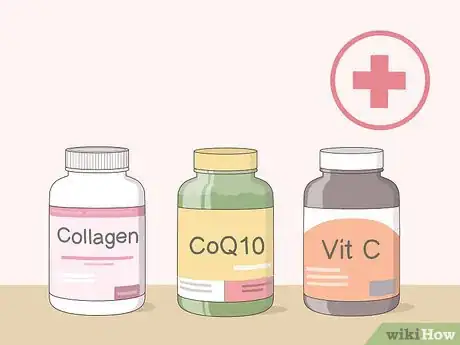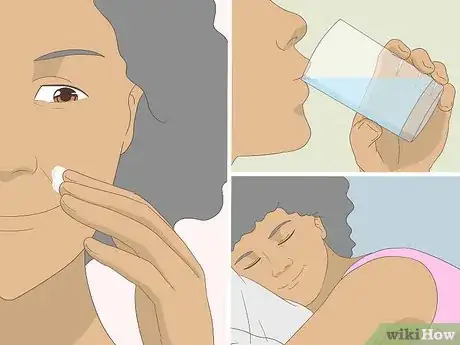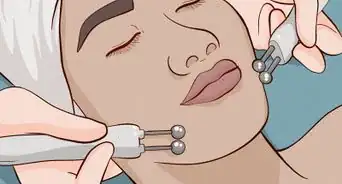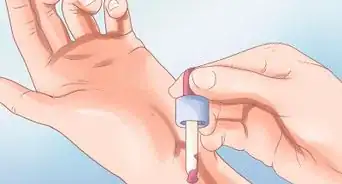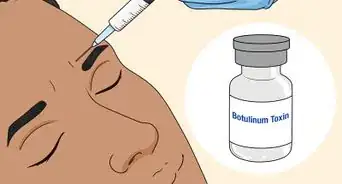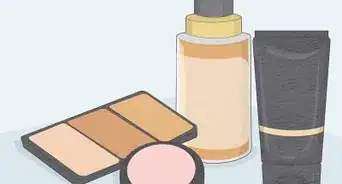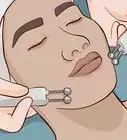This article was medically reviewed by Luba Lee, FNP-BC, MS. Luba Lee, FNP-BC is a Board-Certified Family Nurse Practitioner (FNP) and educator in Tennessee with over a decade of clinical experience. Luba has certifications in Pediatric Advanced Life Support (PALS), Emergency Medicine, Advanced Cardiac Life Support (ACLS), Team Building, and Critical Care Nursing. She received her Master of Science in Nursing (MSN) from the University of Tennessee in 2006.
There are 19 references cited in this article, which can be found at the bottom of the page.
wikiHow marks an article as reader-approved once it receives enough positive feedback. In this case, several readers have written to tell us that this article was helpful to them, earning it our reader-approved status.
This article has been viewed 599,108 times.
Although it occurs naturally as a part of aging, loosening facial skin can seriously impact your self-confidence. Thankfully, there are several ways to tighten and smooth the skin on your face. Whether you try out a skin-firming moisturizer or commit to a facial treatment, you can help reverse some of the damage and signs of aging on your skin and feel good about the face you present to the world.
Steps
Skin-Firming Moisturizers
-
1Use a collagen cream to keep skin supple. When shopping for skincare products, look for facial moisturizers that contain collagen peptides. Collagen is a part of your skin that helps it remain moisturized and elastic. Over time, the collagen in facial skin breaks down, contributing to both sagging and wrinkles.[1] Using a collagen cream may help replenish your skin’s natural collagen, making your skin appear tighter and more moisturized.
- Not all collagen creams contain the same added ingredients or percentage of collagen. When using a collagen cream, read the label carefully to see how often the cream should be applied.
-
2Try a vitamin C serum to brighten and tighten your skin. Vitamin C serums contain concentrated doses of vitamin C that can tighten skin, reduce sun and age spots, reduce redness, and boost the production of collagen.[2] Unlike drinking vitamin C (which is also healthy!), serums allow your skin direct contact with the vitamin so that the benefits are absorbed right into your skin.
- Vitamin C serums are safe for most skin types, so this is a great option if you have any allergies or skin sensitivities.[3]
- Serums often include other skin-tightening ingredients, including retinols, hyaluronic acid, and collagen peptides.[4]
- Most vitamin C serums are safe to use 1 to 2 times per day. However, always check the label on your vitamin C serum to see how often it is safe to use.[5]
Advertisement -
3Apply a hyaluronic acid serum or cream for hydrated, plump skin. Hyaluronic acid is a naturally-produced molecule that binds water to the collagen in your facial skin. Like collagen, hyaluronic acid breaks down over time, leaving your skin vulnerable to dehydration and sagging. Applying a hyaluronic acid moisturizer daily can help re-hydrate your skin, making it appear tighter and healthier.[6]
- Hyaluronic acid is generally considered a great option for all skin types and does not usually trigger allergic reactions, break outs, or rosacea.[7] Thus, it can usually be added to your daily skincare routine.
-
4Use a cream or serum with glycolic or lactic acid to tighten skin. These products work through exfoliation, meaning they cause shedding of the surface skin. Be aware that using creams with glycolic or lactic acid can increase your skin’s sensitivity to UV. If you start noticing that your skin is getting redder in the sun than before you started using this cream, stop using it and try a different treatment.[8]
- Check the ingredients before you buy, because the concentration of acid should be 10 percent or less to be safe.[9]
-
5Use retinol to reduce the wrinkles on your face. Retinol is one of the most popular skin-tightening ingredients and can be found at almost any pharmacy, drug store, or skincare retailer. Retinol creams have been shown to help reduce wrinkles, tighten skin, and make skin damage less visible.[10]
- While retinol can be the most effective skin-tightening ingredient for some, it comes with a long list of potential side effects, including dryness, irritation, sensitivity to sunlight, redness, swelling, and blistering.
- Because retinols can cause irritation, it is generally recommended that you use them only 2 to 4 times per week. If you experience any side effects, decrease your usage to 1 time per week. Contact your doctor if the side effects persist or are extreme.[11]
- Retinol may also help reduce acne outbreaks.[12]
Professional Treatments
-
1Get a facial massage for a painless overall lift. Facial massages are a generally enjoyable treatment that can help sculpt and lift your skin by working out the muscles in your face. While facial massages can cost several hundred dollars per treatment, you can usually expect long-lasting results after only a few treatments.[13]
- At most skincare establishments, you can choose to add a skin-tightening moisturizer to your facial massage, such as a hyaluronic acid serum, for an added benefit for your skin.
- While getting a facial massage done by a professional will likely produce the best results, you can also purchase an at-home facial massaging tool. These are available online and at several higher-end skincare retailers and generally cost about $50-$500.
-
2Microneedle for quicker skin-tightening results. Microneedling is a minimally invasive, non-surgical procedure that uses micro needles to puncture the skin, causing it to generate new collagen and tissue.[14] While microneedling will likely cause some immediate irritation and redness, these side effects usually subside quickly, leaving you with smoother, firmer, and more toned skin within hours or days.[15]
- When done by a skincare professional, microneedling treatments generally cost between $100 and $700 per treatment. In general, it takes several sessions to achieve the maximum results. The exact number of treatments needed varies greatly depending on your desired results, skin type, and age.[16]
- At-home microneedling devices cost anywhere from $10 to $300. At-home microneedling devices don’t pierce the skin as deeply as medical grade devices, so you won’t see as much change.
- Microneedling at home can help your skin-tightening moisturizer penetrate deeper into your skin, making your products more effective.[17]
-
3Get an ultrasound facial treatment for longer-lasting results. Since it was approved by the FDA in 2009, ultrasound energy has become a popular treatment for tightening facial skin.[18] Ultrasound energy treatment is a nonsurgical treatment that pulsates ultrasound heat energy deep into the skin, causing it to lift and tightened. Like other non-surgical treatments, ultrasound energy treatment also boosts collagen production.
- While the procedure is still relatively new, most patients see results within 3 months of their first treatment that lasts for several years.[19]
- On average, one ultrasound energy treatment costs about $2,000.
- Ultrasound energy treatments are noninvasive and usually cause little to no irritation. As such, no recovery time is need, so you can usually return to your regular routine immediately following the treatment.[20]
-
4Try a radiofrequency facial to stimulate collagen production. Similar in many ways to an ultrasound treatment, radiofrequency facials are performed with a machine that uses radiofrequency to heat the deeper layers of your facial skin to increase collagen production. Radiofrequency facials usually result in an immediate tightening of the skin on your face, making it a great option if you have a special event coming up soon.[21]
- Radiofrequency facials usually cost about $100 per half hour session, with the results lasting about six weeks.
-
5Do a laser skin resurfacing procedure to reduce wrinkles. While laser skin resurfacing procedures are usually done to get rid of scars, warts, rosacea, or spider veins, ablative lasers, such as CO2 and Erbium lasers, can also be used to reduce the appearance of fine lines and wrinkles.[22] These lasers help tighten and smooth out your face by removing the top, more damaged layers of your skin.
- The costs of laser skin resurfacing ranges from about $1,000 to $3,000.[23]
- While the procedure is generally safe, laser skin resurfacing should be performed by a doctor with knowledge of your medical history and desired results.[24]
- Laser skin resurfacing is more invasive than other tightening treatments, such as an ultrasound treatment, but less so than a surgical facelift.
- Laser treatments can take up to 3 months to completely heal, but generally produce long-lasting results.[25]
-
6Get a facelift to permanently tighten your face skin. Also known as a rhytidectomy, a facelift is a surgical procedure that removes excess skin, redistributes fat and tissue, and tightens skin on the face and neck.[26] As a surgical procedure, facelifts are highly invasive, expensive, and take several weeks or months to heal. Yet, for many patients, a facelift can produce long-lasting results, making the facial skin feel tighter and smoother for years to come.
- The average cost of a facelift ranges between approximately $7,000 and $12,000.[27]
- There are several serious risks and side effects associated with a facelift surgery, including bleeding, infection, cardiac events, blood clots, severe pain, and prolonged swelling, to name a few.[28]
- Because the procedure is highly invasive and carries a number of risks, not everyone is a good candidate for a facelift. Consult with your doctor to see if it is safe for you to consider getting a facelift.[29]
Natural Techniques
-
1Try facial yoga to gain facial muscle tone. Facial yoga is a series of exercises you do with your face. Studies have shown their effectiveness, particularly in creating fuller cheeks, but only if you are willing to put in a lot of time. To achieve results from facial yoga, practice daily for about half an hour.[30]
- Though facial yoga does require a lot of time, it’s an inexpensive and noninvasive method.
-
2Take supplements that may help tighten facial skin. Recent studies have shown that adding collagen, zinc, CoQ10, and vitamin C supplements to your daily routine can help reduce the appearance of fine lines and tighten the skin on your face.[31] While the jury is still out on how much of a difference supplements can make, it might be worth talking to your doctor about adding a few or all of these supplements to your diet.
- All of these potentially skin-tightening supplements are available in capsule and powder form.
-
3Try a natural face mask for quick skin-tightening results. All-natural face masks are all the rage right now, and with good reason. Generally made with a variety of fruit extracts, vitamins, and other natural skin-tightening agents, such as aloe or collagen, face masks are an easy and inexpensive way to tighten your skin naturally.
- While the long-term effects of face masks are still debated, many of these masks will make your facial skin feel tighter immediately, making them a great short-term option.
- Learn how to make an all natural face mask at home for a particularly inexpensive way to tighten your facial skin.
-
4Prevent loosening skin naturally by taking care of your health. Using sunscreen, drinking plenty of water, getting enough sleep, maintaining a healthy diet, exercising regularly, and avoiding smoking and overindulging in alcohol can all help you maintain your skin’s natural elasticity and prevent loose facial skin. In addition to being preventative, taking care of your health may also help reverse some of the signs of aging and help tighten your skin naturally.
What Should I Avoid When Caring For The Skin On My Face?
Expert Q&A
-
QuestionDo cardio exercises help with getting rid of sagging cheeks?
 Luba Lee, FNP-BC, MSLuba Lee, FNP-BC is a Board-Certified Family Nurse Practitioner (FNP) and educator in Tennessee with over a decade of clinical experience. Luba has certifications in Pediatric Advanced Life Support (PALS), Emergency Medicine, Advanced Cardiac Life Support (ACLS), Team Building, and Critical Care Nursing. She received her Master of Science in Nursing (MSN) from the University of Tennessee in 2006.
Luba Lee, FNP-BC, MSLuba Lee, FNP-BC is a Board-Certified Family Nurse Practitioner (FNP) and educator in Tennessee with over a decade of clinical experience. Luba has certifications in Pediatric Advanced Life Support (PALS), Emergency Medicine, Advanced Cardiac Life Support (ACLS), Team Building, and Critical Care Nursing. She received her Master of Science in Nursing (MSN) from the University of Tennessee in 2006.
Board-Certified Family Nurse Practitioner Gravity affects all of our organs including skin. While high impact cardio has numerous health benefits overdoing it can cause skin to jolt which overtime leads to overstretching and breaking down collagen which in turn lead to sagging skin. Balance cardio exercise with low impact activities such as walking, swimming and yoga. Also, overall health maintenance which includes healthful diet, rest, mindful practices and supportive relationship is important in keeping your face skin healthy and youthful.
Gravity affects all of our organs including skin. While high impact cardio has numerous health benefits overdoing it can cause skin to jolt which overtime leads to overstretching and breaking down collagen which in turn lead to sagging skin. Balance cardio exercise with low impact activities such as walking, swimming and yoga. Also, overall health maintenance which includes healthful diet, rest, mindful practices and supportive relationship is important in keeping your face skin healthy and youthful. -
QuestionWhat can help tighten my facial skin if I have hairs and pores on my face?
 Luba Lee, FNP-BC, MSLuba Lee, FNP-BC is a Board-Certified Family Nurse Practitioner (FNP) and educator in Tennessee with over a decade of clinical experience. Luba has certifications in Pediatric Advanced Life Support (PALS), Emergency Medicine, Advanced Cardiac Life Support (ACLS), Team Building, and Critical Care Nursing. She received her Master of Science in Nursing (MSN) from the University of Tennessee in 2006.
Luba Lee, FNP-BC, MSLuba Lee, FNP-BC is a Board-Certified Family Nurse Practitioner (FNP) and educator in Tennessee with over a decade of clinical experience. Luba has certifications in Pediatric Advanced Life Support (PALS), Emergency Medicine, Advanced Cardiac Life Support (ACLS), Team Building, and Critical Care Nursing. She received her Master of Science in Nursing (MSN) from the University of Tennessee in 2006.
Board-Certified Family Nurse Practitioner There are two parts to my answer: first focuses on the internal processes of addressing underlying imbalances and second focus are external skin treatments. First, hair on your face suggests hormonal imbalance and therefore you should focus on normalizing your hormones especially cortisol. Having a solid daily routine, managing stress by utilizing exercise and relaxation as well as eating anti-inflammatory, low glycemic index foods help to balance your hormones. Second, incorporating the use of topical retinol or and glycolic or lactic acids in your facial products will help to shrink your pores, improve your skin tone and tighten your skin. It is the best to consult your health professional and figure out a holistic treatment plan that would utilize both internal and external tools in a stepwise fashion to help improve your skin.
There are two parts to my answer: first focuses on the internal processes of addressing underlying imbalances and second focus are external skin treatments. First, hair on your face suggests hormonal imbalance and therefore you should focus on normalizing your hormones especially cortisol. Having a solid daily routine, managing stress by utilizing exercise and relaxation as well as eating anti-inflammatory, low glycemic index foods help to balance your hormones. Second, incorporating the use of topical retinol or and glycolic or lactic acids in your facial products will help to shrink your pores, improve your skin tone and tighten your skin. It is the best to consult your health professional and figure out a holistic treatment plan that would utilize both internal and external tools in a stepwise fashion to help improve your skin.
Warnings
- There are devices you can buy to treat your wrinkles by laser at home, but always check that they are FDA-approved before buying them.⧼thumbs_response⧽
- Always consult your primary care doctor and an experienced dermatologist before trying any new skin-tightening treatments or procedures.⧼thumbs_response⧽
- Laser skin resurfacing and facelifts both require that your doctor administer anesthesia. Be sure to talk to you doctor about any risks associated with anesthesia before the procedure.[33]⧼thumbs_response⧽
References
- ↑ https://www.webmd.com/beauty/cosmetic-procedures-collagen#1
- ↑ https://www.healthline.com/health/beauty-skin-care/vitamin-c-serum-benefits
- ↑ https://www.healthline.com/health/beauty-skin-care/vitamin-c-serum-benefits
- ↑ https://www.healthline.com/health/beauty-skin-care/vitamin-c-serum-benefits
- ↑ https://www.healthline.com/health/beauty-skin-care/vitamin-c-serum-benefits
- ↑ https://www.allure.com/story/what-is-hyaluronic-acid-skin-care
- ↑ https://www.allure.com/story/what-is-hyaluronic-acid-skin-care
- ↑ https://www.fda.gov/cosmetics/cosmetic-ingredients/alpha-hydroxy-acids
- ↑ https://www.fda.gov/cosmetics/cosmetic-ingredients/alpha-hydroxy-acids
- ↑ https://www.townandcountrymag.com/style/beauty-products/g25621476/skin-tightening-treatments-at-home/
- ↑ https://www.webmd.com/beauty/retinoid-gel-and-cream-treatments#1-3
- ↑ https://www.webmd.com/beauty/retinoid-gel-and-cream-treatments#1-3
- ↑ https://www.harpersbazaar.com/uk/beauty/skincare/a18717463/facelift-alternative-skin-treatments/
- ↑ https://www.medicalnewstoday.com/articles/324138.php
- ↑ https://www.healthline.com/health/microneedling
- ↑ https://www.healthline.com/health/microneedling
- ↑ https://www.townandcountrymag.com/style/beauty-products/g25621476/skin-tightening-treatments-at-home/
- ↑ https://www.harpersbazaar.com/uk/beauty/skincare/a18717463/facelift-alternative-skin-treatments/
- ↑ https://www.healthline.com/health/ultherapy
- ↑ https://www.healthline.com/health/ultherapy
- ↑ https://www.harpersbazaar.com/uk/beauty/skincare/news/a42867/radiofrequency-facials/
- ↑ https://www.plasticsurgery.org/cosmetic-procedures/skin-rejuvenation-and-resurfacing
- ↑ https://www.webmd.com/beauty/laser-resurfacing#1
- ↑ https://www.webmd.com/beauty/laser-resurfacing#1
- ↑ https://www.webmd.com/beauty/laser-resurfacing#1
- ↑ https://www.plasticsurgery.org/cosmetic-procedures/facelift/procedure
- ↑ https://www.healthline.com/health/face-lift#overview
- ↑ https://www.healthline.com/health/face-lift#overview
- ↑ https://www.healthline.com/health/face-lift#overview
- ↑ https://www.nbcnews.com/better/pop-culture/what-facial-yoga-experts-say-it-really-can-make-you-ncna845596
- ↑ https://www.womansday.com/health-fitness/wellness/a23829699/best-anti-aging-supplements/
- ↑ https://www.healthline.com/health/facial-exercises-are-they-bogus#1
- ↑ https://www.healthline.com/health/face-lift
About This Article
One of the simplest ways to tighten your facial skin at home is with skin-firming moisturizers. Look for a product that contains collagen peptides or hyaluronic acid, which can help replenish your skin’s natural elasticity. If you want a moisturizer that can also even out your skin tone, choose a vitamin c serum. These serums can improve the overall health of your skin and also stimulate the natural production of collagen. Creams or serums that contain ingredients like glycolic acid, lactic acid, or retinol are great for smoothing out your skin and getting rid of spots and wrinkles, and they can also help tighten up your skin. Be careful, though, because they can also cause dryness and irritation for some people. Keep reading for advice from our Medical co-author on how to get your skin tightened professionally!
